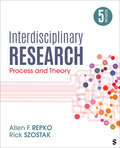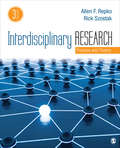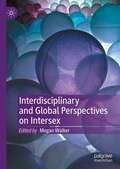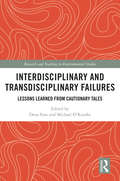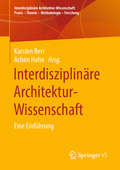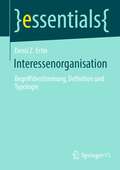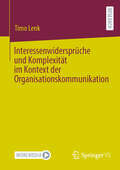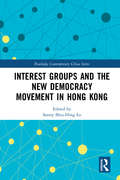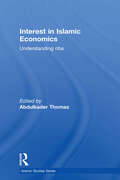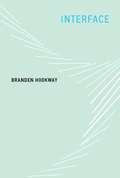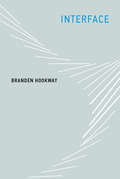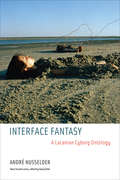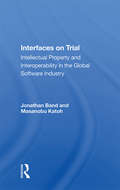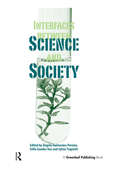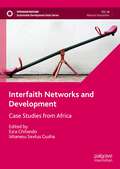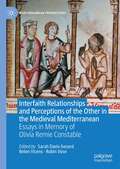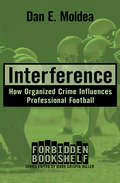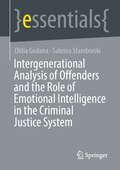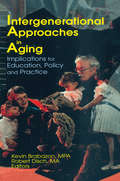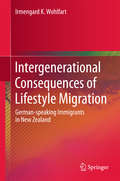- Table View
- List View
Interdisciplinary Research: Process and Theory
by Rick Szostak Allen F. RepkoThis book offers a comprehensive, systematic presentation of the interdisciplinary research process and the theory that informs it by drawing on student and professional work from a variety of fields. The book has been iterative in its development over editions, as the authors have learned from the work of instructors and students using it and have adjusted their advice in response. Notable changes in the Fifth Edition respond to feedback from the Forum devoted to this book in Issues in Interdisciplinary Studies in 2022. Examples have been updated so most are more contemporary, new content has been added on mixed methods and team research to respond to the needs of graduate students, and content has been revised throughout to address the current thinking on interdisciplinarity and integration, and strategies for achieving common ground as an interdisciplinary research team. An instructor website for the book at http://edge.sagepub.com/repko5e includes editable PowerPoint slides, a test bank, and figures and tables from the book.
Interdisciplinary Research: Process and Theory
by Dr Allen F. Repko Professor Rick SzostakThe Third Edition of Interdisciplinary Research: Process and Theory offers a comprehensive and systematic presentation of the interdisciplinary research process and the theory that informs it. Authors Allen F. Repko and Rick Szostak illustrate each step of the decision-making process by drawing on student and professional work from the natural sciences, social sciences, humanities, and applied fields. Designed for active learning and problem-based approaches as well as for more traditional approaches, the book now includes more examples from real student research projects and adds more tables and figures to enliven the discussion.
Interdisciplinary Research: Process and Theory
by Dr Allen F. Repko Dr Richard SzostakThe Third Edition of Interdisciplinary Research: Process and Theory offers a comprehensive and systematic presentation of the interdisciplinary research process and the theory that informs it. Authors Allen F. Repko and Rick Szostak illustrate each step of the decision-making process by drawing on student and professional work from the natural sciences, social sciences, humanities, and applied fields. Designed for active learning and problem-based approaches as well as for more traditional approaches, the book now includes more examples from real student research projects and adds more tables and figures to enliven the discussion.
Interdisciplinary and Global Perspectives on Intersex
by Megan WalkerThis edited collection interrogates how social and cultural representations of individuals with intersex variations impact how they are understood and treated from legal and medical perspectives across the world. Contributors consider how novelists, filmmakers, artists, and medical professionals have represented people with intersex variations, and highlight the importance of ethical representation and autonomy to encourage wider cultural and medical knowledge of intersex variations as a naturally occurring phenomenon. The text also examines the ways in which individuals with intersex variations are represented and viewed in India, Italy, Pakistan and Israel, as well as how this impacts decision making for the individuals, families and medical providers. This book argues that reactions to intersex variations will not change unless they are no longer presented as treatable disorders. It positions representation at the forefront, shifting the emphasis away from a concern for maintaining gender norms to upholding the human rights of intersex people. This volume will be of interest to researchers and scholars in intersex studies as well as policymakers and activists.
Interdisciplinary and Transdisciplinary Failures: Lessons Learned from Cautionary Tales (Research and Teaching in Environmental Studies)
by Dena Fam and Michael O’RourkeUnlike other volumes in the current literature, this book provides insight for interdisciplinary and transdisciplinary researchers and practitioners on what doesn’t work. Documenting detailed case studies of project failure matters, not only as an illustration of experienced challenges but also as projects do not always follow step-by-step protocols of preconceived and theorised processes. Bookended by a framing introduction by the editors and a conclusion written by Julie Thompson Klein, each chapter ends with a reflexive section that synthesizes lessons learned and key take-away points for the reader. Drawing on a wide range of international case studies and with a strong environmental thread throughout, the book reveals a range of failure scenarios for interdisciplinary and transdisciplinary projects, including: • Projects that did not get off the ground; • Projects that did not have the correct personnel for specified objectives; • Projects that did not reach their original objectives but met other objectives; • Projects that failed to anticipate important differences among collaborators. Illustrating causal links in real life projects, this volume will be of significant relevance to scholars and practitioners looking to overcome the challenges of conducting interdisciplinary and transdisciplinary research.
Interdisziplinäre Architektur-Wissenschaft: Eine Einführung (Interdisziplinäre Architektur-Wissenschaft: Praxis – Theorie – Methodologie – Forschung)
by Karsten Berr Achim HahnArchitektur, sichtbar und anschaulich, gestaltet baulich-technisch und räumlich unsere Lebensumwelt und stellt in dieser genuinen Eigenschaft eine besondere Herausforderung an die Wissenschaft(en) dar.Bei den versammelten Beiträgen dieses Bandes handelt es sich um die schriftlichen Fassungen von Vorträgen im Rahmen eines von der DFG finanzierten ‚Rundgesprächs‘ zum Thema ‚Interdisziplinäre Architektur-Wissenschaft‘ im Juni 2018 an der Technischen Universität Dresden – ergänzt von weiteren Autorinnen und Autoren.Der Band ist in vier thematische Schwerpunkte gegliedert. Der erste Teil präsentiert philosophische Grundlagen einer interdisziplinären Architektur-Wissenschaft. Der zweite Teil stellt aus unterschiedlichen disziplinären oder wissenschaftstheoretischen Ansätzen heraus wissenschaftstheoretische und methodologische Grundlagen und Zugriffe bereit. Der dritte Teil beleuchtet das Spannungsverhältnis von Architektur als Disziplin und Praxis zu Architekturtheorie und Architektur-Wissenschaft. Im vierten Teil werden exemplarisch Theoriebildung und Theorien zu Landschaft, Landschaftsforschung und Landschaftsarchitektur diskutiert.
Interdisziplinäre Kreuzungen: Soziologie – Anthropologie – Geschichte
by Wolfgang EßbachDie Aufforderung, über den Tellerrand des eigenen Faches hinauszuschauen, die Einsicht, daß sich nicht unbedingt im Zentrum, sondern an den Rändern von Fächern neuartige Fragen stellen, und die Klagen über den Fachidiotismus sind wohlbekannt. Der geflügelte Spruch des Dichters Jean Paul: „Jeder Fachmann ist in seinem Fach ein Esel“ trifft auch Nur-Soziologen, die nichts von ihrem Fach wissen, wenn sie sich nicht in der Landschaft auskennen, die ihre Disziplin umgibt. Ihre späte Akademisierung hat der Soziologie eine schöne Vielfalt von angrenzenden Nachbarschaften beschert. Dieser Band handelt von Kreuzungen zwischen Soziologie, Anthropologie und Geschichte. In den Studien geht es unter anderem um historische Quellen soziologischen Denkens, um die Erforschung von Biografien, um kulturelle Identität und Migration, die Problemgeschichte der Anthropologie, um Gabe und Rache, um den Ort der Phänomenologie in der Soziologie und Anthropologie artifizieller Lebenswelt, um Postmoderne als Gegenwart oder Epoche, die Begrenzungen des Historismus, das Verhältnis von Subjektivierungsweise und Geschichte, die soziale Funktion von Vergangenheitsrepräsentation und die Frage: Welche Vergangenheit brauchen unsere Kinder?Der Band versammelt Schriften Wolfgang Eßbachs zum inter- und transdisziplinären Verhältnis von Soziologie, Anthropologie, Geschichte und wie sie sich gegenseitig befruchten können.
Interessenorganisation: Begriffsbestimmung, Definition und Typologie (essentials)
by Deniz Z. ErtinDas vorliegende Buch beschäftigt sich mit der Begriffsbestimmung und Definition von Interessenorganisationen. Dabei wird die Nutzung unterschiedlicher Begriffe in der deutschen und englischen politikwissenschaftlichen Literatur diskutiert. Des Weiteren werden auch die begriffsgeschichtlichen und theoretischen Aspekte dieser Begriffe erläutert und ausgeführt. Neben der Definition des Begriffs werden auch die verschiedenen Typologien von Interessenorganisation untersucht und differenziert. Anhand von praktischen Beispielen werden diese Typologien diskutiert und angewendet.
Interessenwidersprüche und Komplexität im Kontext der Organisationskommunikation
by Timo LenkInteressen- und Erwartungswidersprüche sind ein wesentliches Merkmal komplexer Gesellschaften, die unter dem Druck rapider Veränderungen stehen. Sie prägen alle Formen von Organisationen, die von außen wie von innen mit einer Vielzahl heterogener, teils unvereinbarer Interessen und Erwartungen konfrontiert sind: Unternehmen sollen klimaneutral werden, aber weiterhin profitorientiert wirtschaften, die Politik soll gesellschaftliche Transformation vorantreiben, ohne Wohlstand und Arbeitsplätze zu gefährden, und NGOs agieren im Kontext widerstreitender geopolitischer Interessen. Ausgehend von Paradoxie-Perspektiven in der Organisationsforschung und mithilfe der Komplexitäts- und Assemblage-Theorie ergründet die Arbeit die soziale Komplexität solcher Interessen- und Erwartungswidersprüche. Im Fokus steht dabei die Organisationskommunikation. Durch internationale und interdisziplinäre Bezüge deckt die Arbeit die Vielfalt und Mehrdimensionalität solcher Widersprüche auf. Explorative Experteninterviews mit Berater*innen geben Einblick in konkrete Interessen- und Erwartungswidersprüche und die vertrackten Situationen, die sich daraus für Organisationen ergeben.
Interest Groups and the New Democracy Movement in Hong Kong (Routledge Contemporary China Series)
by Sonny Shiu-Hing LoA new era in the democracy movement in Hong Kong began on July 1, 2003, when half a million people protested on the streets, and has included the 2012 anti-National Education campaign, the 2014 Occupy Central Movement and the rapid rise of localist groups. The new democracy movement in Hong Kong is characterized by a diversity of interest groups calling for political reform, policy change and the territory’s autonomy vis-à-vis the central government in Beijing. These groups include lawyers, teachers, students, nativists, workers, Catholics, human rights activists, environmental activists and intellectuals. This book marks a new attempt at understanding the activities of the various interest groups in their quest for democratic participation, governmental responsiveness and openness. They are utilizing new and unconventional modes of political participation, such as the Occupy Central Movement, cross-class mobilization, the use of technology and cyberspace, and human rights activities with cross-boundary implications for China’s political development. The book will be useful to students, researchers, officials, diplomats and journalists interested in the political change of Hong Kong and the implications for mainland China.
Interest Rate Policies in Developing Countries
by International Monetary FundIn recent years, the appropriate level and structure of interest tates have come to be seen as major issues in connection with stabilization programs undertaken by members. These issues arise from consideration both on the demand side, as interest rates affect the magnitude of aggregate demand, and on the supply side, as they influence the volume and quality of investment and, thus, the growth of output.
Interest in Islamic Economics: Understanding Riba (Routledge Islamic Studies Series)
by Abdulkader ThomasWith Islamic banking gradually becoming a more influential factor in the West, an analysis of the concept of riba – a definition of which is not given in the Qur’an – is long overdue. This text presents readers with various interpretations of this Islamic economic concept – generally perceived as ‘interest’. Thomas provides a framework for understanding riba by examining: linguistics classical judicial analysis the historical context modern economics. Including contributions from prominent international scholars, the book fills a gap in the existing literature and will be welcomed by academics and professionals with an interest in Islamic studies, economics and legal history.
Interface
by Branden HookwayIn this book, Branden Hookway considers the interface not as technology but as a form of relationship with technology. The interface, Hookway proposes, is at once ubiquitous and hidden from view. It is both the bottleneck through which our relationship to technology must pass and a productive encounter embedded within the use of technology. It is a site of contestation -- between human and machine, between the material and the social, between the political and the technological -- that both defines and elides differences. A virtuoso in multiple disciplines, Hookway offers a theory of the interface that draws on cultural theory, political theory, philosophy, art, architecture, new media, and the history of science and technology. He argues that the theoretical mechanism of the interface offers a powerful approach to questions of the human relationship to technology. Hookway finds the origin of the term interface in nineteenth-century fluid dynamics and traces its migration to thermodynamics, information theory, and cybernetics. He discusses issues of subject formation, agency, power, and control, within contexts that include technology, politics, and the social role of games. He considers the technological augmentation of humans and the human-machine system, discussing notions of embodied intelligence. Hookway views the figure of the subject as both receiver and active producer in processes of subjectification. The interface, he argues, stands in a relation both alien and intimate, vertiginous and orienting to those who cross its threshold.
Interface (The\mit Press Ser.)
by Branden HookwayA cultural theory of the interface as a relation that is both ubiquitous and elusive, drawing on disciplines from cultural theory to architecture.In this book, Branden Hookway considers the interface not as technology but as a form of relationship with technology. The interface, Hookway proposes, is at once ubiquitous and hidden from view. It is both the bottleneck through which our relationship to technology must pass and a productive encounter embedded within the use of technology. It is a site of contestation—between human and machine, between the material and the social, between the political and the technological—that both defines and elides differences.A virtuoso in multiple disciplines, Hookway offers a theory of the interface that draws on cultural theory, political theory, philosophy, art, architecture, new media, and the history of science and technology. He argues that the theoretical mechanism of the interface offers a powerful approach to questions of the human relationship to technology. Hookway finds the origin of the term interface in nineteenth-century fluid dynamics and traces its migration to thermodynamics, information theory, and cybernetics. He discusses issues of subject formation, agency, power, and control, within contexts that include technology, politics, and the social role of games. He considers the technological augmentation of humans and the human-machine system, discussing notions of embodied intelligence.Hookway views the figure of the subject as both receiver and active producer in processes of subjectification. The interface, he argues, stands in a relation both alien and intimate, vertiginous and orienting to those who cross its threshold.
Interface Fantasy: A Lacanian Cyborg Ontology (Short Circuits)
by Andre NusselderBehind our computer screens we are all cyborgs: through fantasy we can understand our involvement in virtual worlds.Cyberspace is first and foremost a mental space. Therefore we need to take a psychological approach to understand our experiences in it. In Interface Fantasy, André Nusselder uses the core psychoanalytic notion of fantasy to examine our relationship to computers and digital technology. Lacanian psychoanalysis considers fantasy to be an indispensable “screen” for our interaction with the outside world; Nusselder argues that, at the mental level, computer screens and other human-computer interfaces incorporate this function of fantasy: they mediate the real and the virtual. Interface Fantasy illuminates our attachment to new media: why we love our devices; why we are fascinated by the images on their screens; and how it is possible that virtual images can provide physical pleasure. Nusselder puts such phenomena as avatars, role playing, cybersex, computer psychotherapy, and Internet addiction in the context of established psychoanalytic theory. The virtual identities we assume in virtual worlds, exemplified best by avatars consisting of both realistic and symbolic self-representations, illustrate the three orders that Lacan uses to analyze human reality: the imaginary, the symbolic, and the real. Nusselder analyzes our most intimate involvement with information technology—the almost invisible, affective aspects of technology that have the greatest impact on our lives. Interface Fantasy lays the foundation for a new way of thinking that acknowledges the pivotal role of the screen in the current world of information. And it gives an intelligible overview of basic Lacanian principles (including fantasy, language, the virtual, the real, embodiment, and enjoyment) that shows their enormous relevance for understanding the current state of media technology.
Interfaces On Trial: Intellectual Property And Interoperability In The Global Software Industry (The\information Society Ser.)
by Jonathan BandThis book presents the history of one of the key debates in the continuing effort to develop a legal framework for intellectual property rights in the burgeoning computer software industry. It is the first full account of the interoperability debate-the controversy over the protectability of interface specifications and the permissibility of
Interfaces between Science and Society
by Ângela Guimarães Pereira Sofia Guedes Vaz Sylvia TognettiThe project of science has been to provide answers to questions about the world and how it works. Often, this lofty role has been characterised by a narrow and dogmatic scientific training, an unwillingness to communicate to differing stakeholder needs, a refusal to accept and to manage uncertainty, complexity and value commitments, and the reduction of knowledge assessment to colleague peer review on narrowly technical issues. Times have changed. As the world faces increasingly disparate challenges, science is subjected to increasingly vehement demands from a society calling for transparency, openness and public participation in science policy. Science is going through an evolutionary process. Perhaps the most painful process it has ever encountered. Research on the interfaces between science and society is a burgeoning area. A new conception of knowledge now appears to be emerging, based on the awareness of complexity, uncertainty and a plurality of legitimate perspectives and interests. Democracy is extending into the previously quite exclusive scientific realm, and science must now submit to public scrutiny and participation in the governance of knowledge. This book provides much-needed reflections on the methods and tools for knowledge quality assurance, particularly on its inputs to extended policy and decision-making processes. The overall aim is to improve the relationship between science and society. The discussion involves six themes: communicating between plural perspectives; accepting and learning how to manage uncertainty, complexity and value commitments; acknowledging new conceptions of knowledge; implementing transparency, openness and participation in science policy; valuing community-based research; and exploring how new ICT can support inclusive governance. Taken together, these themes provide both a framework and vision on how to conceive, discuss and evaluate the changes that are occurring. The chapters cover theory, practice, approaches, experiences, ideas and suggestions for a move beyond "talking the talk" to "walking the walk". Science and policy interfaces are dynamic processes needing to permanently redefine themselves and their roles. This book contributes to the enrichment and deepening of our understanding of these important new trends in the social relations of science, which are fundamental to our understanding of the prospects for further progress. The book will be essential reading for scientists, policy-makers, managers and the public.
Interfacing Ourselves: Living in the Digital Age
by Cristina Bodinger-DeUriarteInterfacing Ourselves consists of new work that examines digital life on three levels: individuals and digital identity; relationships routinely intertwining digital and physical connections; and broader institutional and societal realities that define the context of living in the digital age. A key focus is what it means in varied social arenas when most individuals live as co-present or multi-present—simultaneously engaged in digital and physical space—alone and with others. Topics include how: digital life contributes to well-being; individuals experience digital dependency; a smartphone is more than a smartphone; netiquette reveals social change; some online communities become prosocial salient havens while others reinforce social inequality; Millennials build intimacy; Latinx do familismo; and digital surveillance and big data redefine consumerism, advocacy, and civic engagement. Six chapters incorporate insights from hourly journals of Millennials undergoing a period of digital abstinence. Other chapters draw from surveys, digital auto-ethnography, content analysis, and other methods to explore digital life at the level of individual and interactive experience, and at a broader institutional and societal level. Ultimately, the book presents the need for living a mindful digital life by developing greater awareness as an individual, a social being, and a netizen and citizen.
Interfaith Networks and Development: Case Studies from Africa (Sustainable Development Goals Series)
by Ezra Chitando Ishanesu Sextus GushaAlthough there is growing interest in the role of religion in meeting the United Nations Sustainable Development Goals (SDGs), Agenda 2030, very few studies have focused on the contributions of interfaith networks. Most of the contemporary publications on religion and development focus on single religions or faith-based organizations. This volume addresses the lacuna in the available scholarship by undertaking detailed analyses of how interfaith networks in diverse African contexts contribute to development. Chapters in this volume engage in theoretical debates on interfaith networks and development, while describing concrete, fresh case studies on how particular interfaith networks are contributing towards the meeting of the SDGs in specific contexts. Thus, the volume describes older and newer interfaith networks and analyses their achievements and challenges. Contributors focus on SDGs that include peacebuilding, gender, youth, the environment, as well as overviews of interfaith initiatives in different African contexts.
Interfaith Relationships and Perceptions of the Other in the Medieval Mediterranean: Essays in Memory of Olivia Remie Constable (Mediterranean Perspectives)
by Sarah Davis-Secord Belen Vicens Robin VoseThis book is a collaborative contribution that expands our understanding of how interfaith relations, both real and imagined, developed across medieval Iberia and the Mediterranean. The volume pays homage to the late Olivia Remie Constable’s scholarship and presents innovative, thought-provoking, interdisciplinary investigations of cross-cultural exchange, ranging widely across time and geography. Divided into two parts, “Perceptions of the ‘Other’” and “Interfaith relations,” this volume features scholars engaging with church art, literature, historiography, scientific treatises, and polemics, in order to study how the religious “Other” was depicted to serve different purposes and audiences. There are also microhistories that examine the experiences of individual families, classes, and communities as they interacted with one another in their own specific contexts. Several of these studies draw their source material from church and state archives as well as jurisprudential texts, and span the centuries from the late medieval to early modern periods.
Interference: How Organized Crime Influences Professional Football (Forbidden Bookshelf #6)
by Dan E. MoldeaA shocking exposé of widespread corruption and mob influence throughout the National Football League—on the field, in the owners&’ boxes, and in the corporate suitesAccording to investigative journalist Dan E. Moldea, for decades the National Football League has had a strong and unspoken understanding with a dangerous institution: organized crime. In his classic exposé, Interference, Moldea bares the dark, sordid underbelly of America&’s favorite professional team sport, revealing a nest of corruption that the league has largely ignored since its inception.Based on intensive research and in-depth interviews with coaches, players, mobsters, bookies, gamblers, referees, and league officials—including some of the sport&’s all-time greats—the author&’s shocking allegations suggest that the betting line is firmly in the hands of the mob, who occasionally manipulate the on-field action for maximum profit. Interference chronicles a long-standing history of gambling, drugs, and extortion, of point-shaving and game-fixing, and reveals the eye-opening truth about numerous gridiron contests where the final results were determined even before the kickoff. Moldea exposes the mob connections of many of the team owners and their startling complicity in illegal gambling operations, while showing how NFL internal security has managed to quash nearly every investigation into illegality and corruption within the professional football world before it could get off the ground. Provocative, disturbing, and controversial, Interference is a must-read for football fans and detractors alike, offering indisputable proof that what&’s really happening on the field, in the locker room, and behind the scenes is a whole different ball game.
Interfirm Networks in the Japanese Electronics Industry (The University of Sheffield/Routledge Japanese Studies Series)
by Ralph PaprzyckiInterfirm Networks in the Japanese Electronics Industry analyses changes in production networks in the Japanese electronics industry. Japan's post-war success in the assembly industries is frequently attributed to innovative approaches to the organization of production: Japanese assemblers have tended to forge intricate networks of long-term interfirm business relationships. Traditionally, these networks have been characterized by hierarchical interfirm relationships resembling a pyramid. Paprzycki argues that as a result of global industry dynamics, such monolithic 'pyramidal' production networks have come under mounting pressure and are giving way to an increasing diversity of network arrangements. A major contributing factor is the growing cost and complexity of technology, which forces even the largest manufacturers to look beyond traditional network boundaries in order to gain access to complementary (technological) assets and capabilities.
Intergenerational Analysis of Offenders and the Role of Emotional Intelligence in the Criminal Justice System (essentials)
by Otilia Gudana Sabrina StamborskiIn 1996, violence was declared and identified as a global health problem. The risk of homicide and suicide reached epidemic proportions and affected specific population groups, including youths and members of minority groups. The suicide rates among adolescents and young adults (ages 15 to 24) nearly tripled between 1950 and 1990. Similarly, the homicide rates among males aged 15 to 19 almost doubled from 1985 to 1991. These trends raised global alarm and demanded new solutions. The motivation behind this book was to compare the level of emotional intelligence of criminals in prisons and forensic psychiatric facilities. The main objective of this analysis is to focus on recommendations for emotional intelligence training to reduce the epidemic rates of violence among inmates on a global level.
Intergenerational Approaches in Aging: Implications for Education, Policy, and Practice
by Robert Disch Kevin BrabazonIn Intergenerational Approaches in Aging: Implications for Education, Policy, and Practice, leading practitioners and academics from a variety of disciplines come together to discuss theoretical issues, current practice, and future directions for this rapidly developing field. The authors address key topics such as defining the intergenerational field, the effects of the segregation of groups by age on social function and organization in our communities, and designing, implementing, and assessing programs that create cross-generational connections. Exploring ways to provide services to different age groups while tapping the strengths and skills of each age group, Intergenerational Approaches in Aging examines the application of intergenerational approaches to important social issues as well as specific challenges faced by practitioners. It makes suggestions for integrating intergenerational studies into the higher education system and for challenging segregated services and funding programs. As the book shows, promoting cooperation between diverse segments of society also depends on:making intergenerational programming a permanent feature of public schoolsunderstanding and meeting the social, mental health, and medical needs of grandparents who are raising their grandchildrenusing observational research to study and evaluate intergenerational program effectiveness and the relationships among the people involvedviewing differences among people as assetsdeveloping intergenerational program modelsproviding children with a 'life-cycle’view of the worldIntergenerational Approaches in Aging offers the personnel of state and local agencies on aging, nursing homes, senior centers, and geriatric homes practical advice, innovative ideas, and supportive materials for developing and implementing intergenerational activities and programs that can benefit all parties involved. Academics and school administrators will also benefit from this book as they learn concrete methods for integrating aging education into already existing curricula and building new conceptual frames of reference for a wide variety of social issues and historical topics.
Intergenerational Consequences of Lifestyle Migration
by Irmengard K. WohlfartThis book explores the adaptation processes of German-speaking immigrants and their descendants into New Zealand's predominantly Anglophone society. Specifically, it considers the experiences and long-term consequences of the migration of more affluent European immigrants to New Zealand, where migration was predominantly a lifestyle choice. A comprehensive four-year study adds insights into the social integration and assimilation processes of the immigrants and their descendants, including intercultural marriage behaviour, work and educational achievements and community enrichments. It also considers the institutional and social reception of these immigrants and their children in New Zealand, and the effects these have had on them. Nexus Analysis reveals that strong motives for lifestyle migration enabled the immigrants to cope with unexpected institutional setbacks in New Zealand, and finds both shifts and maintenance in language and culture, and explores feelings of belonging and identities across three generations.
